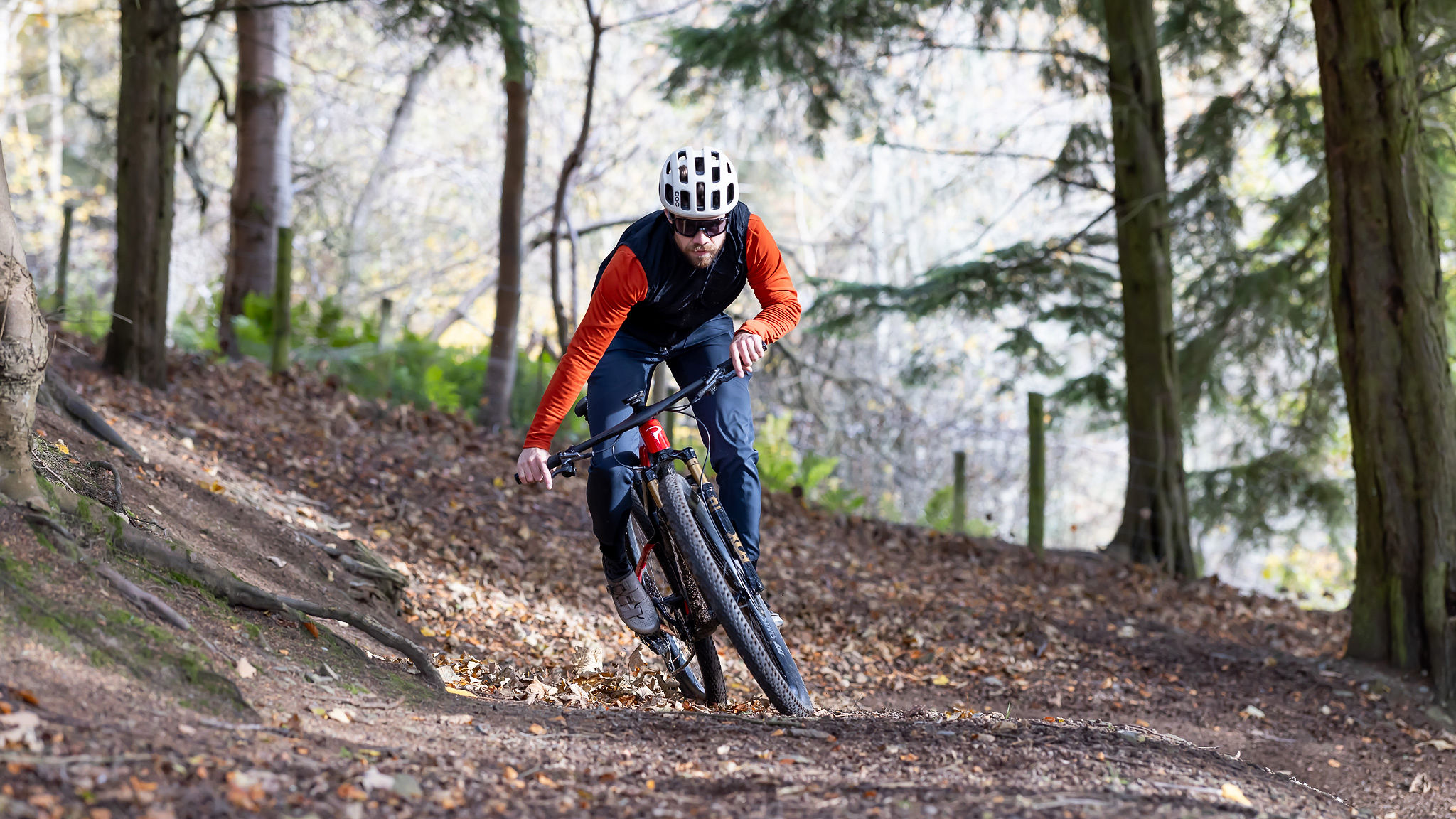Best chains for mountain bikes, gravel and road
Boost your performance with Bike Perfect's roundup of the best chains for mountain bikes, gravel and road
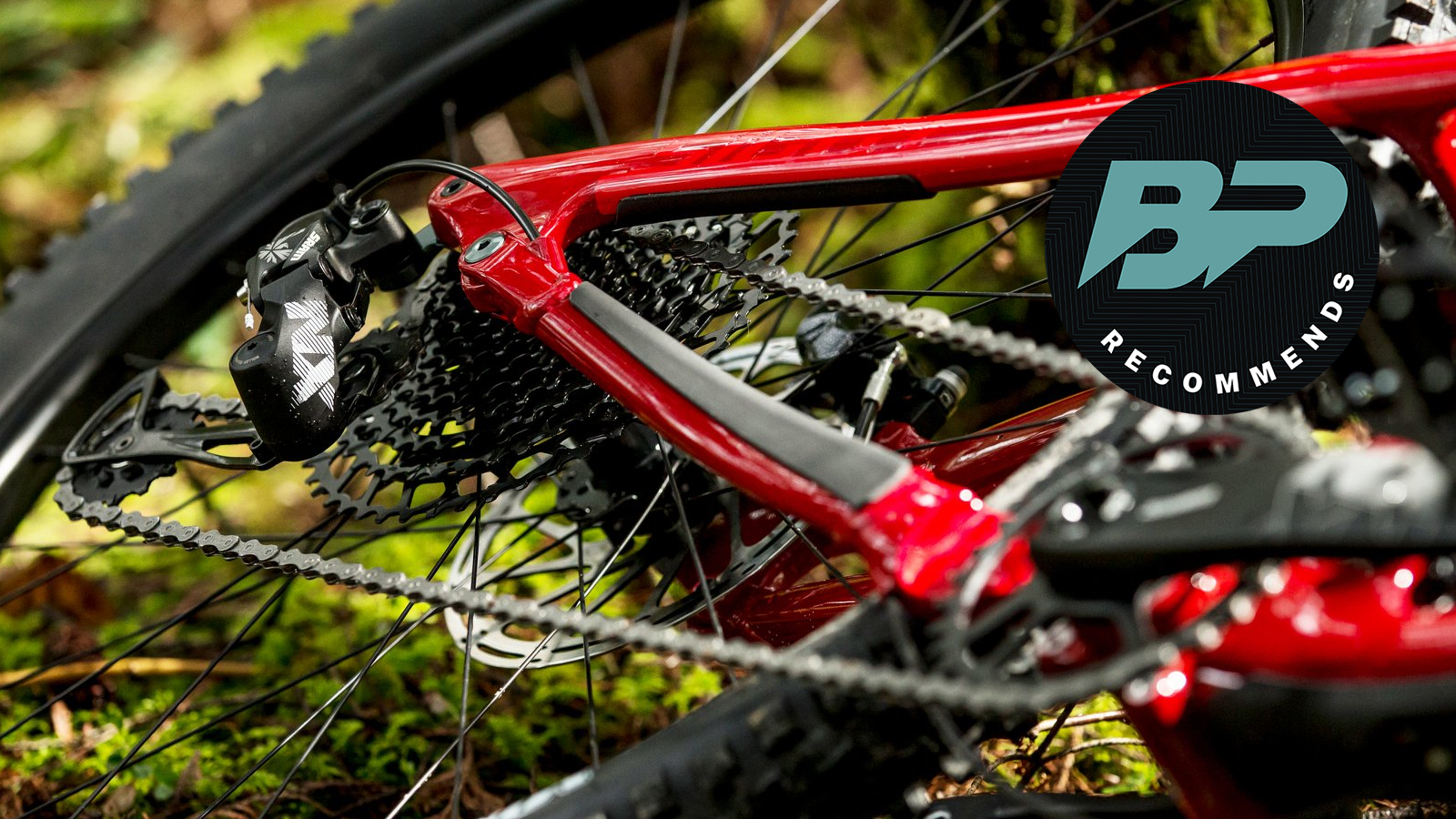
- 1. Best for SRAM Eagle 12-speed
- 2. Best for SRAM T-Type
- 3. Best budget SRAM road and gravel 12sp
- 4. Best for low friction
- 5. Best for corrosion resistance
- 6. Best budget Shimano 12sp
- 7. Best for SRAM gravel and road
- 8. Best for Shimano 11sp
- 9. Best for Shimano 12sp
- 10. Best for lightweight
- 11. Best for performance
- How to choose the right chain for you
1. Best for SRAM Eagle 12-speed
2. Best for SRAM T-Type
3. Best budget SRAM road and gravel 12sp
4. Best for low friction
5. Best for corrosion resistance
6. Best budget Shimano 12sp
7. Best for SRAM gravel and road
8. Best for Shimano 11sp
9. Best for Shimano 12sp
10. Best for lightweight
11. Best for performance
How to choose
When you think about possible upgrades, you might not immediately consider switching to the best chains for mountain bikes, gravel, and road bikes. However the type and brand of chain you choose will have a surprisingly big impact on how smoothly your bike runs. In fact, choosing the right chain is just as important as equipping your bike with the best mountain bike cranks and bottom brackets. Plus if you want to get the best performance out of your chain, don't forget to invest in one of the best chain guides.
The chain is often the fastest-wearing component on a bike, and it's a crucial part of drivetrain performance in terms of wear and wattage saving - you don't need us to remind you of the importance of drivetrain maintenance. However, despite this, they’re very possibly one of the most neglected or overlooked items too.
For this buyer's guide, in addition to our own testing, we’ve pulled together the best independent data from the excellent Zero Friction Cycling as well as factoring tens of thousands of hours of riding feedback from our sister site Cyclingnews. We’ve also gathered intel from our biking buddies, from enduro e-bikers to time trialists.
Unsurprisingly, that’s thrown up a wide range of options, but it’s also pointed out some solid recommendations to work with for every type of rider, whether your priorities are sheer speed, epic longevity, or cost-effective value for 11- or 12-speed systems.
So if you're serious about keeping your drivetrain happy, which are the best chains for mountain bikes, gravel bikes, and road bikes, in terms of durability and drag? Read on for our round-up of those worthy of your consideration, or jump ahead to find out how to choose the right chain for you.
Best chains for mountain bike, gravel and road
Why trust BikePerfect
1. Best for SRAM Eagle 12-speed
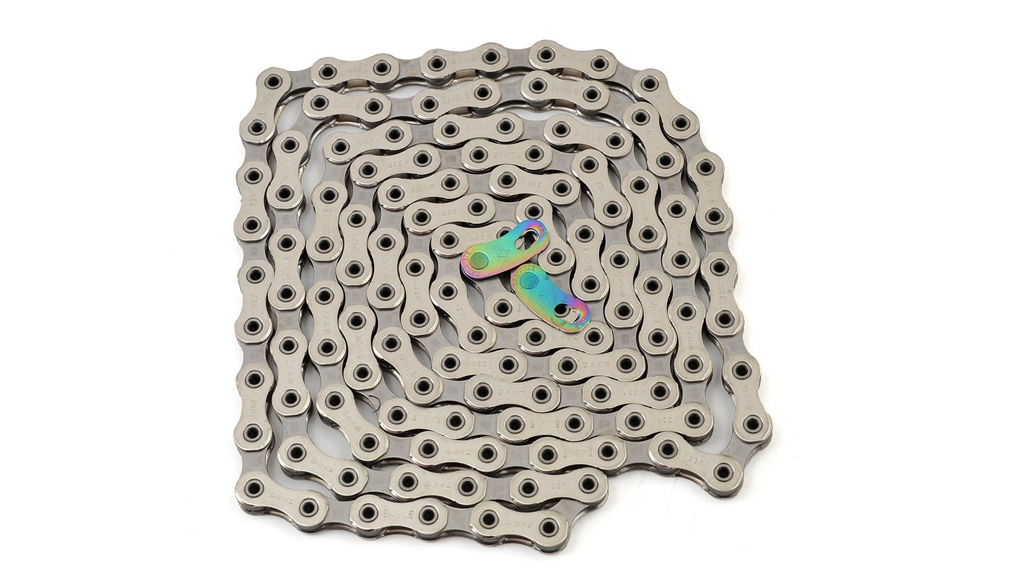
SRAM X01 Eagle
Specifications
Reasons to buy
Reasons to avoid
SRAM’s X01 Eagle chain misses out on the gold anodized finish of the XX1 Eagle chain but it’s a lot cheaper. It’s still the same hard-chrome surface treatment reducing friction and massively extending lifespan according to lab tests, and more importantly our own experience in the worst conditions.
You get allegedly stronger hollow pins, too. While some tests we’ve seen say they’re fractionally less efficient, we always feel the opposite when they’re teamed with an X-Sync2 chainring. The ‘humped’ PowerLink joining links seem tougher and quieter than most, and the shape and rainbow finish make them easy to find in the chain.
The hard-wearing performance means they can chew through other brand components very fast, but an X01 chain is an excellent and noticeable upgrade for any Eagle setup.
2. Best for SRAM T-Type
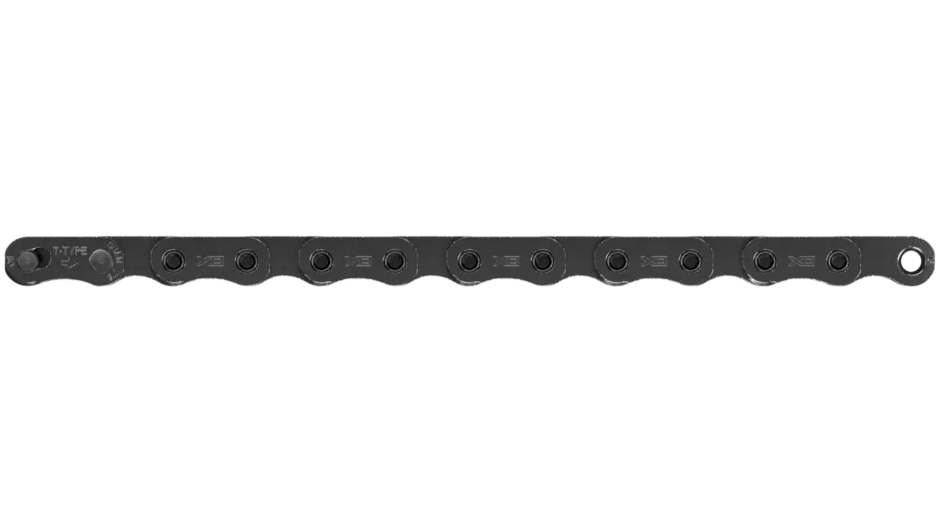
SRAM X0 Eagle Transmission Flattop Chain
Specifications
Reasons to buy
Reasons to avoid
The introduction of SRAM's T-Type Transmission brought a full ecosystem of T-Type-specific components. Although the new X0 Eagle Transmission chain shares the same Flattop design as the drop bar chains, it has been completely re-engineered and thus the MTB and road/gravel chains are not cross-compatible.
SRAM's Transmission was touted as a more durable drivetrain and the chain shares the same approach, with SRAM claiming that this is the strongest and most wear-resistant chain it has made. SRAM's Hard Chrome technology is said to increase resistance against chain stretch by four times and the electroless nickel plating and PVD coating should help keep corrosion at bay.
It also comes in an X0-specific Polar finish if you want a full stealth look.
3. Best budget SRAM road and gravel 12sp
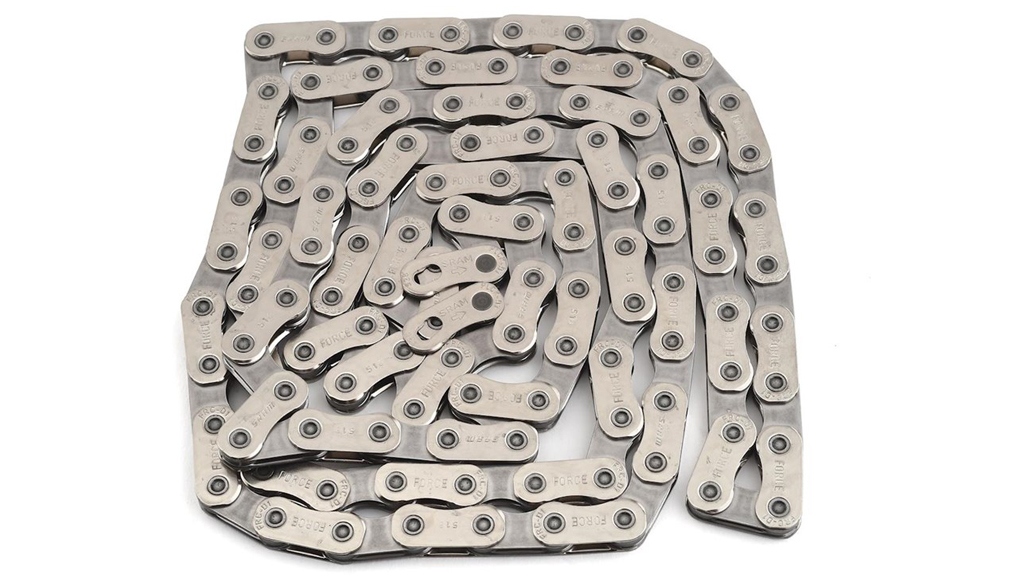
SRAM AXS Force
Specifications
Reasons to buy
Reasons to avoid
The second-tier version of SRAM’s AXS transmission ‘ecosystem’ gets the same narrower-but-stronger big roller, asymmetric ‘Flattop’ link design as the flagship Red chain. It gets the same epic lifespan ‘Hard-Chrome’ finish, too. The lack of hollow pins makes it a bit heavier but we’ve had no problem with the solid pin construction so far and it means they can serve it up for half the price making them an AXS bargain.
4. Best for low friction
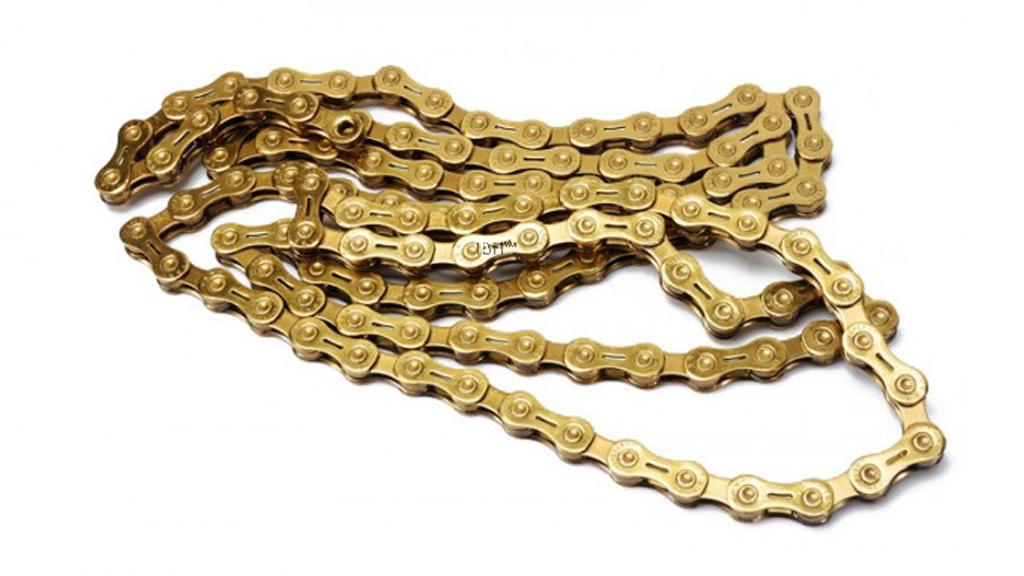
YBN SLA Gold
Specifications
Reasons to buy
Reasons to avoid
Australian chain and lube specialist Zero Friction Cycling has devoted years to searching out the best chains to sell. That makes the fact that YBN’s SLA is its go-to 11-speed chain a big deal and it's got the data (minimal-drag properties) to back it up. YBN's SLA chains last well too, not least because the surface coatings sync well with the highest-performance lubricants. Chromium carbide hardened rollers definitely help too, and weight weenies can even opt for titanium rollers to save 15-20g depending on chain length.
Pricing is relatively expensive however, they’re very hard to find in bricks and mortar shops, and lazy Googling will just drop you onto the Young British Naturists site. Shifting is good with all 11-speed systems as well as SRAM and Campagnolo 12-speed. The gold Ti-Nitride finish looks killer on most bikes.
5. Best for corrosion resistance

Wippermann Connex 11SX
Specifications
Reasons to buy
Reasons to avoid
German chain brand Wippermann has a very loyal following, particularly among powerful, high-mileage riders. The top-of-the-line SX gets stainless steel inner plates to remove any corrosion issues. It feels clean and efficient on the bike and that sensation is backed up by lab results we’ve seen.
The Speed Wing outer plate also helps initiate shifting early for swift and responsive changes on all mech types we’ve tried. Wippermann has a deservedly good reputation for longevity and strength on- and off-road which makes this slightly higher than average price a good investment over time. Unlike most brands the split link is reusable, so removal for deep cleaning is free and easy. Be sure to refit the link and chain the right way round though, or the directional shaping will skip, particularly on smaller cogs.
6. Best budget Shimano 12sp
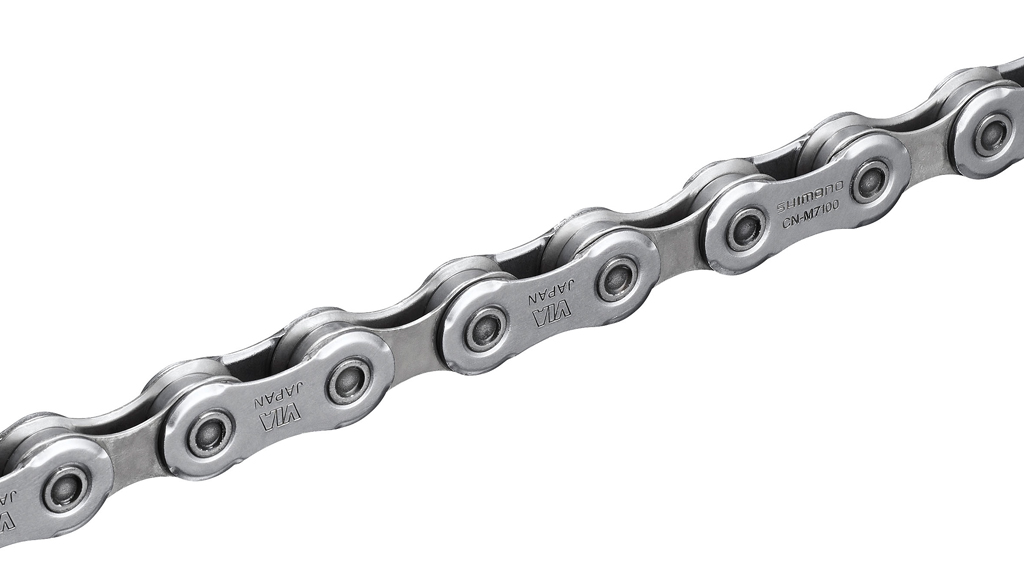
Shimano M7100 SLX
Specifications
Reasons to buy
Reasons to avoid
Shimano has a habit of loading all its top tech into lower groupsets over time, but it's really given riders on a budget a bargain bonus with the recent SLX introduction. The chain sums it up nicely too as it delivers all the same Hyperglide+ shaping tweaks and Dynamic Chain Engagement roller upgrades. You even get Shimano’s Sil-Tec low-friction Flourine coating for extra slickness so the only thing you’re missing is hollow pins.
The new XT and SLX only started appearing in summer so we’ve no big bank of long-term data yet, but so far our sets have been churning through a particularly grim autumn and winter without issue. They seem more rust-resistant than other similarly priced chains when we aren’t on point with our cleaning and lubing routine, too.
7. Best for SRAM gravel and road
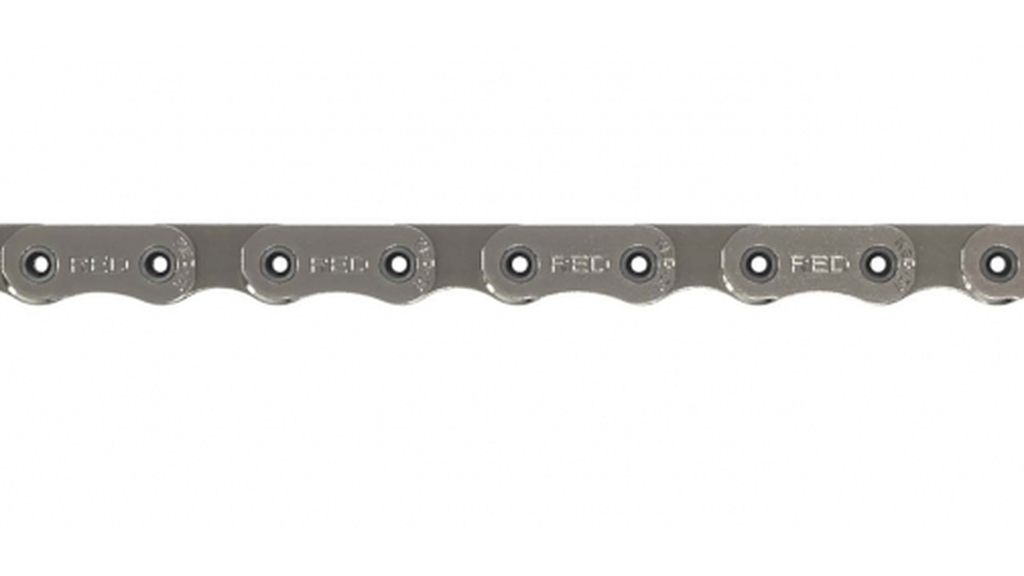
SRAM AXS Red
Specifications
Reasons to buy
Reasons to avoid
SRAM’s 12-speed AXS groupset introduced a new X-Range chainring and cassette sizes, but the flat-topped chains are probably the most striking ‘why-has-nobody-thought-of-that-before’ piece of the system.
The asymmetric links are stronger despite being narrower and ‘Hard Chrome’ roller and inner face surface treatment is giving outstanding lifespans so far. The hollow pins are lighter and also create a stronger link according to SRAM. The oversized rollers mean they only work on AXS systems though and Force chains with solid pins are half the price.
8. Best for Shimano 11sp
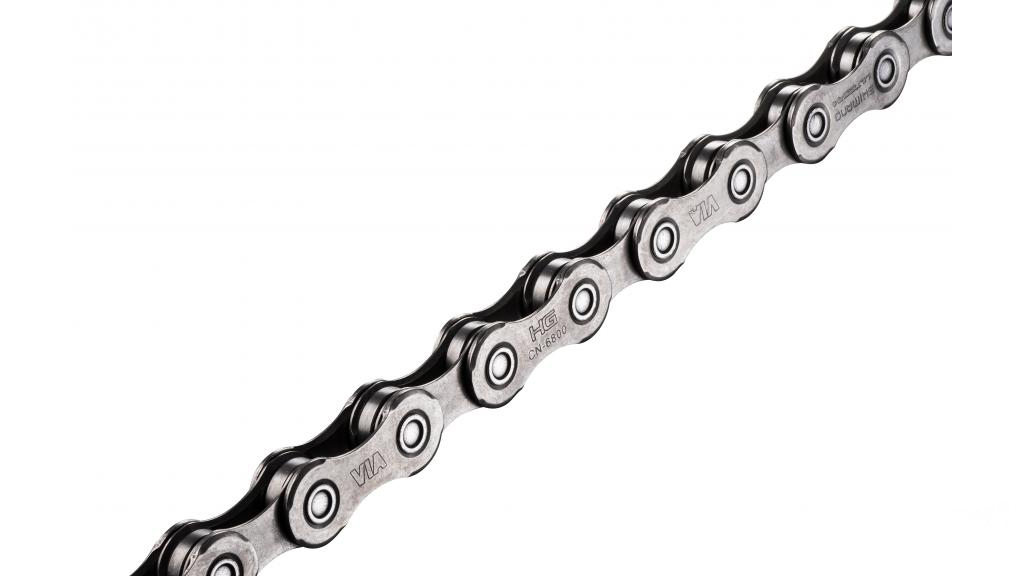
Shimano 6800 Ultegra
Specifications
Reasons to buy
Reasons to avoid
Ultegra is definitely Shimano’s sweet-spot road chain with very efficient test results, thanks to chamfered plates that shift sweetly across 11-speed setups. You also get a bayonet fit ‘Quick Link’ to finally finish years of snap rivet chain joining misery. While Dura-Ace tends to test slightly faster (and right at the top of the heap) Ultegra sits in a price/performance sweet spot according to extensive anecdotal evidence from our rider and workshop panel and available lab data. The bigger gaps load up well with waxy lubes and durability is on par with other decent quality 11-speed chains as long as you stay away from SRAM cassettes.
9. Best for Shimano 12sp
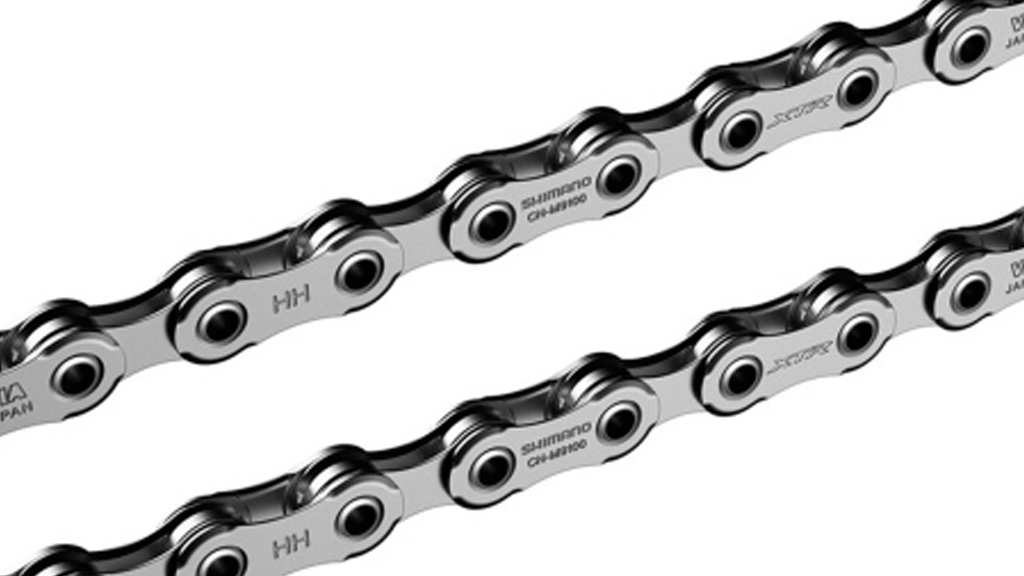
Shimano M9100 XTR
Specifications
Reasons to buy
Reasons to avoid
XTR was Shimano’s first 12-speed, single-ring optimized group and therefore the first one to use its Dynamic Chain Engagement roller tech and Hyperglide+ link and tooth shape evolutions. It’s also got Shimano’s Sil-Tec low-friction Flourine coating and hollow pins. The result is probably the best-shifting off-road set-up around and it’s proving significantly more durable than Shimano 11-speed chains in the real world and lab testing, too. The QuickLink is way easier to work with than the old snap rivet system and it’s also cheap for a top-end chain. It still doesn’t quite match top-end Eagle in toughness though and you can get all the same tech (but without hollow pins) in the recently introduced XT and SLX chains.
10. Best for lightweight
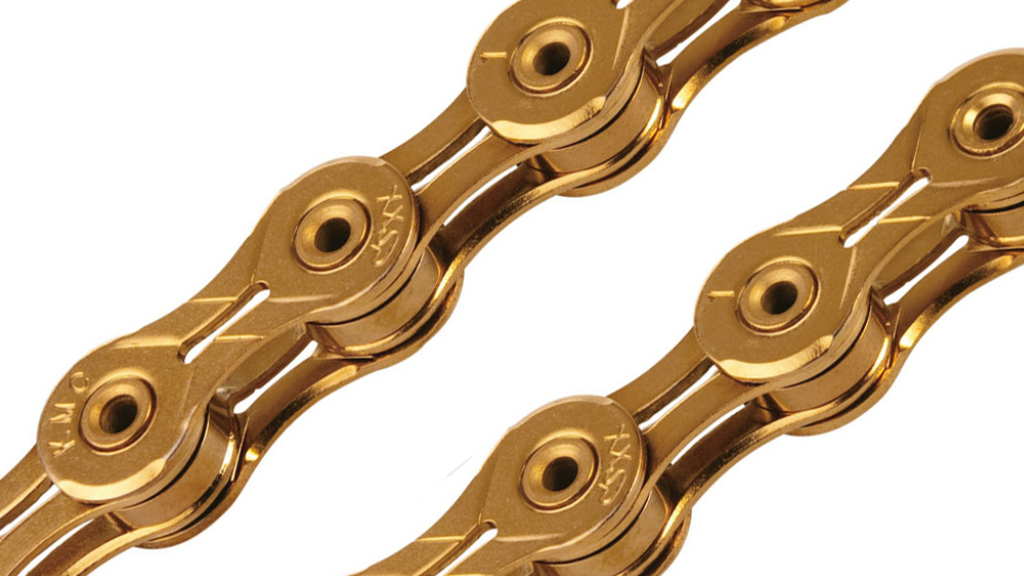
KMC X11 SL
Specifications
Reasons to buy
Reasons to avoid
KMC chains are a cost-saving choice on a lot of complete bikes and they generally do okay. Shifting generally isn’t as good as same brand setups and corrosion tends to be faster in less caring homes, but look after them and they tick round reliably enough. The Ti-Nitride-coated Super Light features a gilded defense against rusting though and the slippery finish also boosts efficiency to Shimano-like levels. The slotted links shave out a few grams if you’re really trying to lighten your load but leave less failsafe strength if you slur a shift under torque or the chain gets crunched on a log/rock.
11. Best for performance
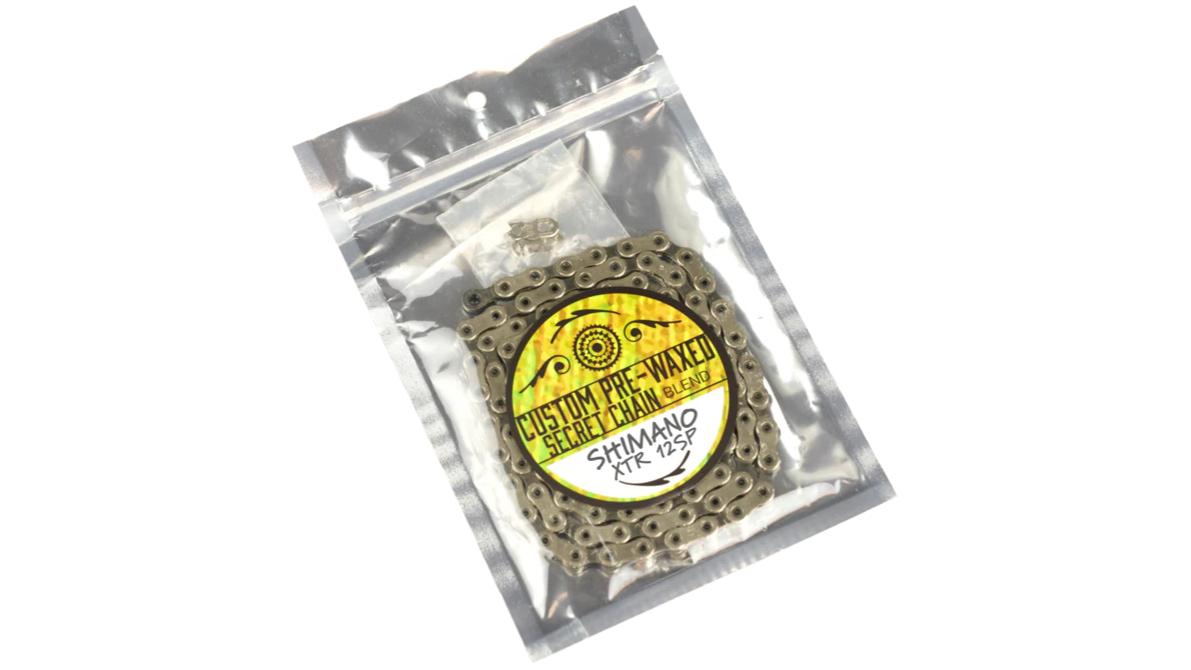
Silca Pre Waxed Race chain
Specifications
Reasons to buy
Reasons to avoid
For ultimate smooth drivetrain performance waxing your chain is the way to go. You can do this at home, however, Silca removes the hassle with its Pre Waxed Race chain.
Available chains are compatible with all performance drivetrains, they are stripped clean and treated with Silca's ultra-premium Hot Wax X. Hot Wax X is the only wax that uses Nanene, which is at high purity graphene, as a friction modifier.
This is a race day chain and best kept for when you need the silkiest drivetrain, promising to be 20 percent faster, saving up to a claimed 12w over an untreated chain. Silca quotes that the Hot Wax X treatment lasts up to 500km but recommends topping it up with Silca's Super Secret Chain Coating.
How to choose the right chain for you
How do I buy the right chain for my bike?
As with most bike components, one chain size doesn't fit all, and you need to make sure the one you buy is compatible with your drivetrain. There are a number of different factors to consider when buying the best chain for your mountain bike, so here's a breakdown of them.
Do I need to replace my cassette as well?
If you don't know a huge amount about maintaining drivetrains then this question is probably ringing some alarm bells, but the fact is before anything else, it's crucial that you check your current chain for wear before you replace it, which you can do with a Park Tool Chain Checker.
The reason for this is that over time and use, the metal-on-metal friction that takes place between the chain and the cassette will wear both those components down until they need replacing.
If both parts are completely worn, then both need to be replaced, otherwise you'll be putting a fresh chain onto a worn cassette, and that will result in the chain wearing at a much higher rate than it would if the cassette were also fresh. If you're investing in a good quality chain, you want to make it last as long as possible.
However this isn't all doom and gloom, because if you replace the chain before it reaches a certain point of wear and tear, then you can keep your cassette in the running for longer and not need to shell out more money than you wanted to.
If you're good at staying on top of this, and regularly check your chain for wear, then you could quite easily get about three chains' worth of use out of your cassette before you need to change it.
How do I know which speed to get?
Chains are sold as suitable for a given number of cogs on the rear cassette, and will be labeled as a particular 'speed' (e.g. 10-speed or 11-speed).
This is important because more cogs demand a narrower chain to fit in the smaller gaps, and likewise, a single-speed will have a chunkier chain as it doesn't need to move up and down through a selection of cogs, so its main job is to stay put. So the number of gears you have will dictate the 'speed' type of chain you need, which informs the width of the chain itself.
Determining which 'speed' chain you need to go with your current drivetrain setup is easy, just count the number of cogs on your rear cassette. Unless your bike is very old, the number will most likely be between seven and 12.
Which is the best chain brand?
All transmission brands prefer you to use their own chainrings and cassettes, and in general, it's a good idea. For example, our experience suggests SRAM equipment is generally ‘harder’ so its chains wear out ‘softer’ Shimano rings and cassettes very quickly, while Shimano chains die fast on SRAM hardware.
SRAM’s AXS flat-top chains also have larger rollers, which are transmission-specific and the Dynamic Chain Engagement and Hyperglide+ evolutions on Shimano’s new 12-speed groupsets definitely make a tangible difference.
So if it's a choice between Shimano and SRAM for you, then stick to whatever brand cassette you have. However there are other brands out there with the most common being KMC, YBN and Wippermann. Generally these brands - ones without a matching transmission - will sit somewhere in between and work fine with whatever you have.
How long should a chain last before it needs replacing?
How long is a piece of string? It's difficult to give a real answer to this question because it depends on so many factors. How often are you riding it, and how far? Do you leave your bike outside in the rain? How often do you clean and lube your chain?
What we can say is it's been calculated that a typical 116-link chain produces over 40,000 surface-against-surface movements per minute at a typical pedaling cadence. That’s a lot of micro friction even in a perfectly clean environment, but even summer road riding comes with a fair dose of dust and grit getting into those bearing surfaces. Head off-road in winter and a chain can turn from showroom shiny to squeaking, grinding, corrosion-breeding casualties in under an hour.
Obviously, the conditions you ride in have a massive influence on longevity, but the published data we’ve seen backs up our own experience that SRAM 11- and 12-speed chains generally live longest, with Campagnolo and YBN close behind, but Shimano’s relatively recently introduced XTR 12-speed chain looking like a stronger-and-stronger contender with every passing month on our long term setup.
How much should I spend on a new bike chain?
There’s a definite temptation to just buy the cheapest option that your local shop or preferred online supplier has in your favorite brand. There are points where it’s worth paying more or less, though.
SRAM’s Hard Chrome finish on its top chains boosts longevity dramatically right through the transmission so XX1, X01 and Red are worth the investment. We’ve found NX and SX Eagle chains are noticeably faster to rust if you don’t lube immediately after washing too.
Ultegra is definitely a sweet spot in the Shimano groupsets range, and KMC’s latest premium chain seems to definitely be a step above previous, cheaper offerings, while Campagnolo and YBN have a much more linear performance to price ratio.
Are expensive bike chains worth it?
There’s a lot of hype online about which chains will save you the most watts in mechanical drag and a premium chain will measurably outperform a cheaper one in clean conditions. After all, we’re talking about just 5 watts at 250 watts (2 percent) between top-end and top-value chains.
That's far less than the difference between a chain that's well-maintained, and one that's filthy. It's also less than the difference made by using a good or bad lube, or tucking behind a wheel.
In other words, unless you’re doing time trials on a regular basis, we’d concentrate more on longevity than power loss when choosing.
How should I care for my bike chain?
Whatever chain you have, cleaning and lubing it thoroughly and immediately after a ride will always significantly boost its performance and longevity. Some tests we’ve seen suggest it can make a tenfold difference in extreme situations and we know that a chain that’s been left to rust and lock solid will never feel that good again, however much you scrub and wax it.
That's why it's hugely important to maintain your drivetrain properly. If you're not sure how to do it, we've got a guide to how to clean a mountain bike, which has a whole step dedicated to cleaning and lubricating.
As we said before, chain wear translates directly to wear on expensive cassettes and chainrings. It also increases the chance of something skipping or jamming and ripping off a mech, breaking a spoke or scarring a frame. So take care of your chain to keep everything else on your bike happy for longer.

Guy Kesteven has been working on Bike Perfect since its launch in 2019. He started writing and testing for bike mags in 1996. Since then he’s written several million words about several thousand test bikes and a ridiculous amount of riding gear. He’s also penned a handful of bike-related books and he reviews MTBs over on YouTube.
Current rides: Cervelo ZFS-5, Specialized Chisel, custom Nicolai enduro tandem, Landescape/Swallow custom gravel tandem
Height: 180cm
Weight: 69kg
